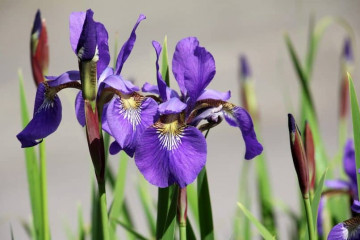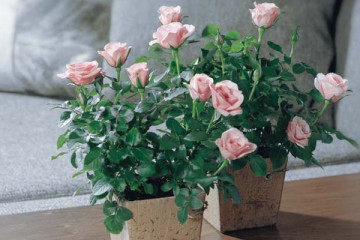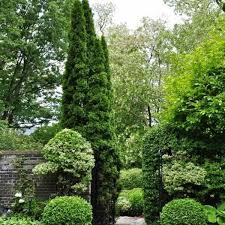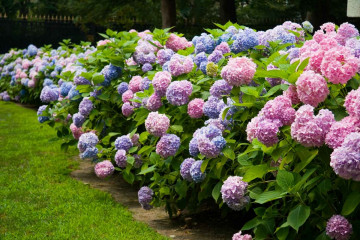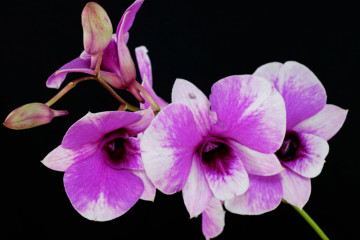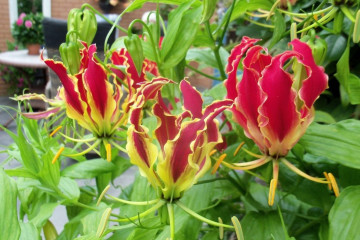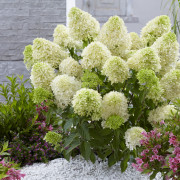Thuja care in spring and after planting outdoors
Content:
Green thuja is an excellent decoration for any garden and even a windowsill. Gardeners after wintering are faced with the problem of yellowing or blackening of the needles. To avoid these troubles, it is necessary to properly care for the plant. How to care for thuja in the country at home, below in the article.
Thuja care at home on the street
Thuja is a plant that should be properly cared for and know the nuances for each season. The main thing in taking care of the tree is the right place and watering regime. With the observance of the main rules, you can achieve excellent results and enjoy the green beauty.
You need to start taking care of the tree immediately after winter. Care should be continued in spring, summer and autumn. The mistake of many gardeners is too reckless attitude to the plant. In their opinion, she is not at all fastidious and does not require special attention to herself. But this is wrong, and gardeners get dull yellowed or blackened bushes. But it is quite possible to avoid these consequences if you properly organize the care of the thuja.
Features of spring care
Spring is the most important period in thuja care. After winter, the plant is weak, and any environmental impact can be destructive: the needles will begin to turn red.
In winter, the trees are covered with an airtight material. Due to the first spring sun, the needles and root system can burn out, which will lead to drying and yellowing of the plant or even death.
The soil should also be prepared. To do this, even during planting, it was worthwhile to provide a high-quality drainage layer and mulch the soil. A large amount of moisture for thuja can be destructive. In addition, the ground around the plant must be cleared of grass and loosened to provide sufficient air.
The irrigation regime must be established in April, and in some regions in March. This is due to the fact that moisture begins to evaporate with the first sun, which must be replenished. In the spring months it will be enough to water the thuja once a week at the rate of one bucket of water per tree. In addition, sprinkling for the needles is recommended weekly.
The next step is to remove the dead branches. All yellowed needles must be cut off. On large trees, damaged branches can be in the very middle, so it is worth carefully examining the plant.
Spring is the time when it is necessary to feed young trees that are just gaining growth. Fertilizers are applied as soon as the snow melts. An excellent option would be both organic and mineral dressings. You can also find specialized coniferous fertilizers.Before feeding the plant, it is worth watering and mulching the soil well so that the fertilizers are better absorbed.
Summer care rules for thuja
Evergreens require combined and regular maintenance during the summer months. Watering and sprinkling, loosening the soil, removing weeds and applying fertilizers are mandatory.
How often the thuja is watered in the hot months is a question that worries many gardeners. At an average temperature, watering and sprinkling is sufficient once a week, in hot weather it can be increased up to two times. After a couple of days, the earth should be loosened to saturate it with air.
Features of thuja care in autumn and preparation for winter
Thuja care is necessary throughout the year, but each period has its own characteristics. In the fall, the tree prepares for winter, so in September it is worth stopping feeding the plant in order to stop the growth of young shoots.
In late autumn, thuja is prepared for wintering. To do this, the branches are tied, the most rolling and curves are cut off, and the soil is mulched. To protect from wind and sunlight, shrubs should be covered with an airtight cloth and left until spring.
Features of preparation for winter in different regions
In regions with heavy snow and winds in winter, such as the northwest of the country, it is recommended to create additional protection for the shrub with wooden shields. In the Middle Lane, you can get by with loose material.
How to care for thujas after planting
After planting, the shrub requires special attention. Caring for newly planted thujas depends on time. If the shrub was planted in summer or spring, then you will need:
- weekly watering in warm weather and two times in hot weather. For irrigation, it is better to use water at room temperature;
- spraying must be carried out once a week, and in hot weather every day in the evenings.
If the tree was planted in the fall, then:
- watering is carried out in the same mode as for spring and summer plantings;
- under the condition of heavy rains, watering must be reduced or stopped, since an excess of moisture is destructive for thuja.
There is no need to feed the plants after planting. Fertilizers are applied during planting, they are enough for the next two years.
When and how to plant
Spring, summer and autumn are suitable for planting thuja. Gardeners recommend spring, so that the young tree has time to get stronger by the first frost.
Before planting, you need to make sure that the seedling is healthy and ready for planting. The needles should be green and not crumble, and there should be no visible damage on the trunk. For planting, it is best to choose a place protected from direct sunlight, slightly shaded.
The soil for planting must be prepared in advance. The soil must be moistened and free from clay, otherwise the shrub will be prone to yellowing. Also, too high humidity should not be allowed, as this is fraught with the fall of greenery.
Landing technology:
- Dig a hole depending on the size of the root system, but at least 80 cm deep.
- Lay expanded clay at the bottom, making a drainage layer.
- When planting thuja in the spring, add fertilizer to the soil mixture, in the fall it is not worth it.
- Place the seedling in the hole, slightly deepening the root collar.
- Cover with soil and tamp.
After planting, follow the recommendations for the care of the seedlings.
How often to water the thuja
Thuja watering regime depends on weather conditions. It is recommended to water the plant for the first time in the spring. In the warm season, the shrub should be watered once a week at the rate of one bucket per average tree.In hot weather, watering should be increased up to 2 times a week. Water is best used at room temperature.
Sprinkling should also be done regularly once a week. When the temperature rises, you can moisten the needles daily.
How to make it lush
Its needles are of great importance for the thuja. If she is healthy, then the plant will become lush and beautiful. To achieve this, the shrub should be tended in early spring and done throughout the year. At the same time, monitor the watering regime and top dressing. Fertilizers can be used organic and mineral. They should be brought in from the first spring months and throughout the spring and summer, and in the fall it is no longer worth it. Subject to the listed conditions, the shrub at the summer cottage will delight with its lush greenery.
Prerequisites are pruning thuja branches and giving it a different shape.
Pruning diseased branches and forming a crown
Throughout the year, it is necessary to monitor the health of the thuja, and especially the branches. If dry or diseased processes are found, they must be cut off urgently.
The first inspection should be carried out in early spring, when the protective material will be removed from the shrub. All dry and damaged branches are pruned.
Large trees should be inspected more closely, as infested parts may be in the middle. You can trim thuja in spring and autumn. In the first case, pruning is carried out in order to shape, and in the second, to prepare for winter.
According to general recommendations, only 1/3 of all branches should be cut at a time. The procedure is best done on a cloudy day, and at the end, pour the thuja thoroughly.
Pests and diseases
The most common shrub pests include:
- thuja aphid;
- bark beetle;
- moth-ring;
- spider mite.
The most common diseases:
- cabbage necrosis;
- pestalocyopsis necrosis;
- phomopsis necrosis;
- brown shute.
To combat and treat pests and diseases, it is necessary to use special means and process at the first signs of infection. But it is best to prevent ailments and the appearance of parasites, therefore, a thorough and regular inspection of the plant for harmful organisms is necessary.
Features of growing thuja in garden pots
Some varieties of thuja can be planted in indoor pots. These plants grow well at home, but they require special treatment.
For a potted plant to feel comfortable, you must:
- choose a well-lit place near the window. Sunlight should be diffused, since direct rays are contraindicated;
- watering the thuja at home should be 1-2 times a week;
- when grown at home, observe a temperature regime of a maximum of 30 ° C, a minimum of 15 ° C. In summer, it is best to put the pot on a balcony or loggia;
- feed the plant regularly in spring and summer once a month.
Even the Moscow climate is suitable for such cultivation of thujas.
If you take care of the thuja correctly, then it will look great in the summer cottage and in the home pot. Thuja requires close care both at home and on the street. If this is neglected, then the plant will constantly suffer from diseases and attacks of pests and eventually dry up.





